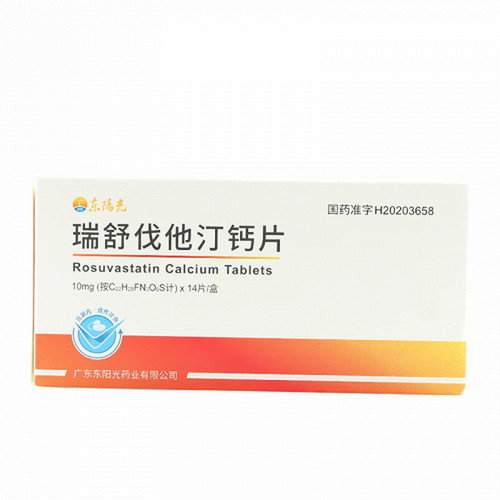Product Overview
[Drug Name]
Generic Name: Rosuvastatin Calcium Tablets
Trade Name: Jingnuo Rosuvastatin Calcium Tablets 10mg x 28 tablets
[Main Ingredient]
Rosuvastatin calcium. Chemical Name: Bis-[(E)-7-[4-(4-fluorophenyl)-6-isopropyl-2-[methyl(methylsulfonyl)amino]-pyrimidin-5-yl](3R,5S)-3,5-dihydroxyhept-6-enoic acid] calcium salt (2:1).
[Properties]
Jingnuo Rosuvastatin Calcium Tablets are film-coated tablets that appear white or off-white after removal of the coating.
[Indications/Main Functions]
Indicated for primary hypercholesterolemia (type IIa, including heterozygous familial hypercholesterolemia) or mixed dyslipidemia (type IIb), whose dyslipidemia cannot be adequately controlled with diet and other non-drug therapies (e.g., exercise therapy, weight loss).
[Precautions]
1. Renal Effects: Proteinuria (as measured by dipstick) has been observed in patients treated with high doses, particularly 40 mg. The majority of the protein originates from the renal tubules and, in most cases, is transient or intermittent. 2. Skeletal Muscle Effects: Skeletal muscle effects, such as myalgia, myopathy, and, rarely, rhabdomyolysis, have been reported in patients treated with all doses of this drug, particularly in doses greater than 20 mg. 3. Creatine Kinase Testing: Creatine kinase (CK) should not be measured after strenuous exercise or in the presence of plausible causes of CK elevation, as this can confound interpretation of the results. If baseline CK values are significantly elevated (>5×ULN), retest within 5-7 days. If repeat testing confirms a baseline CK value >5×ULN, treatment should not be initiated. 4. This drug should not be used in any patient with an acute, severe illness suggestive of myopathy or a predisposition to renal failure secondary to rhabdomyolysis (such as sepsis, hypotension, major surgery, trauma, severe metabolic, endocrine, or electrolyte abnormalities, or uncontrolled epilepsy). 5. Effects on the Liver: As with other HMG-CoA reductase inhibitors, this drug should be used with caution in patients who consume excessive alcohol and/or have a history of liver disease. Liver function tests are recommended before starting treatment and in the third month after initiation. If serum transaminases are elevated more than three times the upper limit of normal, this drug should be discontinued or the dose reduced. 6. For hypercholesterolemia secondary to hypothyroidism or nephrotic syndrome, the underlying disease should be treated before initiating this drug. 7. Effects on Driving and Operating Machinery: Studies to determine the effects of this drug on driving and operating machinery have not been conducted. However, based on its pharmacodynamic properties, this drug is unlikely to affect these abilities. When driving and operating machinery, the possibility of dizziness during treatment should be considered.
[Drug Interactions]
Individuals with allergies to rosuvastatin or any of its ingredients; patients with active liver disease, including those with unexplained persistent elevations in serum transaminases and any elevations exceeding three times the upper limit of normal (ULN); patients with severe renal impairment (creatinine clearance <30 mL/min); patients with myopathy; patients taking cyclosporine concomitantly; and women who are pregnant, breastfeeding, or potentially pregnant and are not using adequate contraceptive measures.
[Specifications]
10mg*28 tablets
[Dosage and Administration]
1. Oral. The usual starting dose is 5 mg once daily. 2. The maximum daily dose is 20 mg. This product can be taken at any time of day, with or without food.
[Adverse Reactions]
1. Adverse reactions observed with this product are generally mild and transient. In controlled clinical trials conducted internationally, less than 4% of patients withdrew due to adverse events. The frequency of adverse events is ranked as follows: Common (incidence >1/100, <1/10); Uncommon (>1/1000, <1/100); Rare (>1/10,000, <1/100); Very Rare (<1/10,000). 2. Rare: Allergic reactions, including angioedema. 3. Neurological disorders. Common: Headache, dizziness. 4. Gastrointestinal disorders. Common: Constipation, nausea, abdominal pain. 5. Skin and subcutaneous tissue disorders. Rare: Pruritus, rash, and urticaria. 6. Skeletal muscle, joint, and bone disorders. Common: Myalgia. Rare: Myopathy and rhabdomyolysis. 7. Systemic disorders. Common: Asthenia. As with other HMG-CoA reductase inhibitors, the incidence of adverse reactions with this product tends to increase with increasing dose. 8. Renal Effects: Proteinuria (detected by dipstick) has been observed in patients receiving this product, with the majority of the protein originating from the renal tubules. Approximately 1% of patients experienced an increase in proteinuria from none or minimal to ++ or greater at certain times during treatment with 10 mg and 20 mg, and approximately 3% of patients receiving 40 mg experienced this increase. A slight increase in proteinuria from none or minimal to ++ was observed with the 20 mg dose. In most cases, proteinuria spontaneously decreased or resolved with continued treatment.
[Contraindications]
Hypersensitivity to rosuvastatin or any component of this product; patients with active liver disease, including unexplained persistent elevations in serum transaminases and any elevation in serum transaminases exceeding three times the upper limit of normal (ULN); patients with severe renal impairment (creatinine clearance <30 mL/min); patients with myopathy; patients taking concomitant cyclosporine; and women who are pregnant, breastfeeding, or potentially pregnant and are not using adequate contraceptive measures.







